Are you having a cesarean section and you want to know how many layers are cut?
In general, there are 6 layers that are cut starting from the skin down to the uterus.
In the vast majority of cases, the only muscle tissue that is cut is the uterus. In some cases, we have to cut your abdominal muscles, but this isn’t very common.
So when do we have to cut your abdominal muscles and what does this mean for your core?
Keep reading to learn more.

How Many Layers Are Cut During A Cesarean Section?
There are 6 layers that we need to get through before we can get to your uterus. They are:
- Skin
- Subcutaneous Tissue
- Fascia
- Rectus Abdominal Muscles
- Peritoneum
- Uterus
Of these 6 layers, the rectus muscle is the only layer that isn’t routinely cut. Every other layer has to be cut to enter the abdominal cavity.
What Muscles Are Cut During A C-Section?
The only muscle that is always cut during a c-section is the uterus. It is a common misconception to think that the rectus abdominal muscles are cut during c-sections. This is actually not true in the vast majority of cases.
Your abdominal muscles are simply separated in the midline to get access to the uterus.
If you didn’t already know, the uterus is a muscle. That is the only muscle that must be cut in order to get your baby out.
When Do You Have To Cut Through The Abdominal Muscle?
There are instances when your abdominal muscles have to be cut. This only happens if your anatomy doesn’t allow easy access to the uterus.
Thankfully, this is rare.
If your rectus muscles are cut, they will be stitched back together.
So Why Is My Core Weak If You Don’t Cut Through Muscle?
Your core may feel weak after a c-section for several reasons.
1) Your rectus muscles are stretched apart as your uterus grows. This will weaken the muscles of your abdomen.
2) You don’t use your core muscles as much throughout the pregnancy. The less you use a muscle, the weaker it will become.
3) We cut through many layers of tissue before we can get to the baby. The majority of these layers are stitched back together and will need time to heal.
Are C-Sections Common?
Yes. The national rate of c-sections is about 30%. This means that anywhere from 1/3 to 1/4 of pregnant women will undergo this surgical procedure.
There are many different reasons to get a c-section. The most common reason is what we call labor dystocia.
This means that your labor doesn’t progress as it should. Either your cervix stops dilating, or your baby doesn’t descend into your pelvis normally.
Other common reasons include:
- Non-reassuring fetal status (aka bad fetal heart rate)
- Breech presentation
- Repeat c-section
- Failed VBAC attempt (vaginal birth after cesarean section)
- Placenta previa
So What Actually Happens During A Cesarean Delivery?
Do you really want to know?
Ok fine.
I’ll go over it step-by-step.
What Can You Expect Before, During, & After The C-Section?
There are two types of c-sections you can have. A scheduled c-section, or an unplanned c-section.
Your experience leading up to the surgery will be different in these situations. Below are the things they have in common.
Spinal/Epidural Anesthesia
Before you can have the procedure done, you will need to be anesthetized. This is commonly done with spinal or epidural anesthesia, aka regional anesthesia.
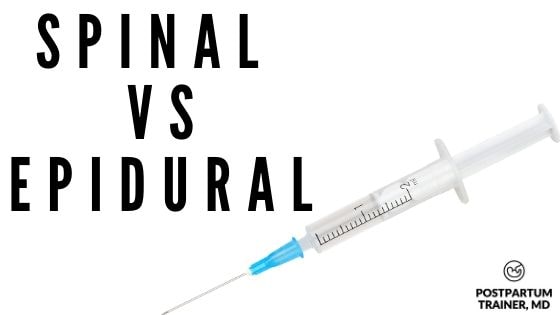
Basically, an anesthesiologist will inject a numbing medication into one of the layers of your spinal canal once you enter the operating room.
Spinal anesthesia is commonly used for planned c-sections. Epidural anesthesia is more common for c-sections that happen after you are in labor.
The medication you receive will numb you from your breast bone down, and you won’t be able to walk for a few hours after the procedure.
*We avoid general anesthesia (which is when you go to sleep and need intubation) for c-sections to minimize the risk of the fetus getting exposed to these medications*
Pfannenstiel Incision (The First Layer)
We begin the procedure by making a 10 cm abdominal incision above your pubic bone near the bikini line with a scalpel. This is the incision we use to get through all six layers previously mentioned.
Also, we do our best to keep the skin incision as small as possible.
*Note: We may shave any pubic hair in your lower abdomen to prevent hair from getting into the surgical field (which is an infection risk)*
The Second Layer and Beyond
After the skin, we cut through the subcutaneous fat, the fascia, and the rectus sheath.
Don’t forget, we split your abdominal muscles down the midline- we do not cut them unless we need to.
Uterine Incision
A small low transverse incision is then made in the uterus to reveal the amniotic sac.
Oftentimes, we use a finger to gently break the sac to release all the amniotic fluid.
A lot of Pressure
After the incision is made on the lower segment of your uterus, you will feel a lot of pressure.
That’s because it’s not easy to get your baby out without additional pressure. The primary surgeon will make the incision on your uterus and reach in to grab the baby.
The assistant surgeon will then provide pressure on your upper abdomen to help guide the baby out of the incision.
Without pressure, the baby won’t come out!
Yes, We Often Take Out (Exteriorize) Your Uterus
After your baby is out, The anesthesiologist will also start oxytocin, a medication to help your uterus contract and decrease postpartum bleeding.
The uterus is then physically taken out of the body. This allows for an easier repair of your uterine incision.
Don’t worry, it goes right back in just as easily.
After your uterus is replaced, all of the layers that were cut are repaired using stitches.
If your abdominal muscles were cut, they will be stitched back together at this point.
You Will Have Vaginal Bleeding
Even though you had a c-section, it is still common to bleed from your vagina. That’s because blood vessels on the inside of your uterus take time to seal off.
In general, you can expect to bleed for about 2 weeks post-delivery, however, each day it should be less and less.
Your provider will order blood tests to look for any signs of anemia on postpartum day 1.
Nausea/Shaking
You will likely experience some nausea and shivering after the surgery and in the recovery room. This is extremely common and thought to be from the anesthesia as well as the changes in your hormone levels.
Pain and Weakness
A few hours after your surgery, the anesthesia will wear off. You’ll likely be in the postpartum unit by this time.
You will start to experience pain around the incision site and it will be difficult to move. Be sure to take your Tylenol and non-steroidal anti-inflammatory (NSAID) medication as needed.
C-sections also tend to have higher blood loss than a vaginal delivery, which can contribute to your fatigue.
A day after your c-section, you should do your best to walk around. (Assuming you didn’t have any major postpartum complications).
How Long Does It Take To Heal After A C-Section?
On average, it can take 6 weeks to start feeling like your normal self again. This means no strenuous activity, heavy lifting, or serious abdominal training.
After 8-12 weeks, your c-section scar will be fully healed and most women begin to feel comfortable doing more activities.
However, every woman is different. You may or may not heal as quickly as other women.
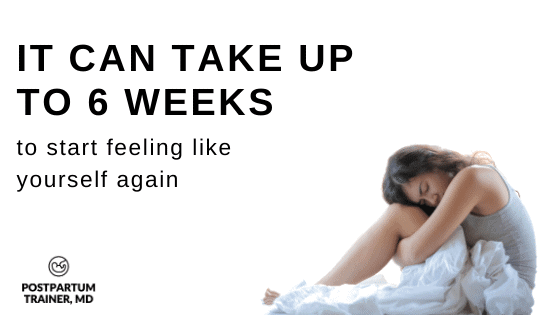
C- Section Recovery Tips
Okay, so what can you do following your c-section to help make sure you recover as quickly as possible?
The very first thing you need to do is move!
Get walking.
Walking is one of the most important things you can do in the postpartum period. Especially if you had a c-section.
Whether your muscles were cut or not, walking will be the most beneficial activity you can do early on.
I further discuss the benefits of walking in the postpartum period in my post- Getting Fit After Pregnancy.
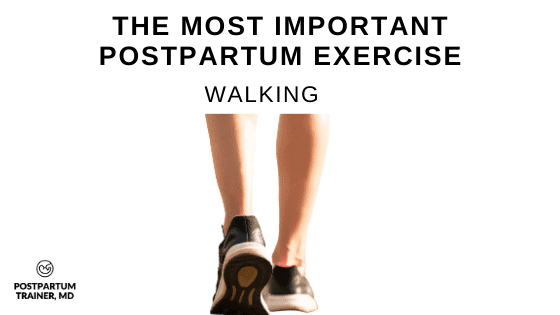
Here are a couple of other things you might consider.
Abdominal Binder
All postpartum women will be offered an abdominal binder shortly after delivery.
This is an elastic band that wraps around your waist. You can adjust it using the velcro to make it as tight as you need it to be. Here is a great abdominal binder you can get from Amazon.
There isn’t great data to show that it has any major impact on recovery, but many women feel better wearing one. You might get some pain relief, or it might help you feel better psychologically.
Get one and see how it makes you feel. If you don’t like it, don’t wear it.
You should only need to wear it for 2-4 weeks.
For more information check out, abdominal binding after c-section, how long should you do it for?
Support Girdle
Another similar device is the postpartum girdle. This is a type of corset that compresses your abdomen and hips.
Again, there is no evidence that this will actually help you with recovery, but you might feel better support while wearing it. Many women prefer this girdle that could be bought on Amazon.
If you do, great. If you don’t, don’t worry about it!
Exercises You Can Do Following A C-Section If Your Muscles Are Cut
If your muscles are cut during a c-section, here are a couple of exercises you can do shortly after delivery to help you regain strength in the core.
Posterior Pelvic Tilts
This is a very simple exercise that you can do while lying down. All you have to do is bend your knees up and concentrate on bringing your belly button down towards the floor.
This will naturally shift your pelvis back and activate your deep core muscles. Hold this position for a 3-count and release.
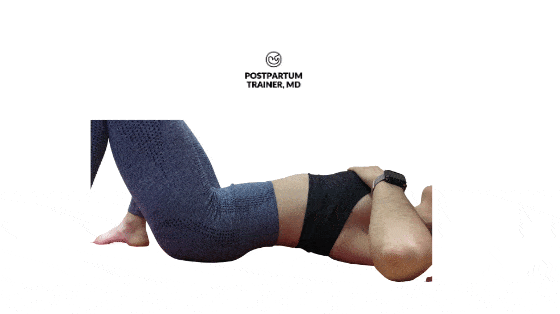
If this exercise causes pain or discomfort – do not do it!
Diaphragmatic Breathing
Diaphragmatic breathing is another simple exercise you can do immediately after your delivery. This exercise will help activate your deep core muscles, the transverse abdominis.
You can do it lying down or sitting up. To start, take a deep breath by expanding your belly as much as you can. Try your best to not breathe into your chest (i.e, don’t shrug up). After you inhale, hold your breath for a 3 count, and then exhale slowly and completely.
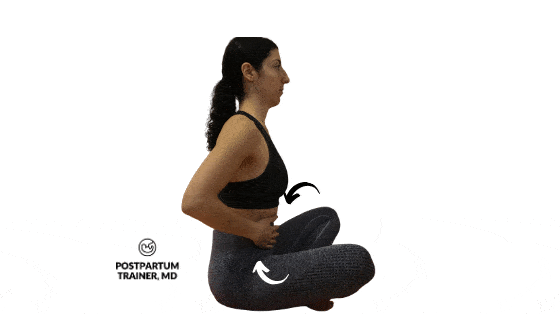
By exhaling as much as you can, your core muscles will be activated.
If this exercise causes pain or discomfort – do not do it!
As time goes on, you’ll be able to do more and more core exercises. Your health care provider will give you more guidance as to what you can and cannot do.
For your convenience, I have created an entire post on exercises to perform post c-section.
Other FAQs
In this last section, I will answer a few other frequently asked questions regarding c-sections and abdominal muscles.
Can I Get Muscle Damage From A C-Section?
It is unlikely that you will get muscle damage from a c-section. Your body is amazing. It will do a remarkable job at healing itself as long as you allow it to heal.
Stay well hydrated, take exercise very slowly, and listen to your doctor.
I Have A Weak Core After A C-Section. Now What?
Almost every woman will have a weak core after a c-section. It’s normal! Even women who had a vaginal birth will have a weak core.
But don’t worry, you will regain your strength.
Start by doing the exercises I recommended above as well as pelvic floor exercises. After you see your doctor and get clearance for more exercises, you can start doing direct core work.
Here is an entire post on how to strengthen your core in the postpartum period.
How Many Layers Are Stitched During A C-Section?
After the baby is delivered, the only layer that isn’t routinely stitched is the peritoneum. Otherwise, your obstetrician will stitch the uterus, the rectus muscles, the fascia, the subcutaneous tissue, and then your skin using dissolvable suture.
How Many Stitches Do You Get After A C-Section Delivery?
In general, each cut layer is closed with one long continuous stitch that is dissolvable. You won’t even see the stitch used to close your skin because it will be located underneath the skin.
What Part of The Uterus is Cut During A Cesarean Section?
During a c-section, a transverse or horizontal incision is made in the lower part of the uterus, known as the lower uterine segment.
If your baby is very premature, you may need a vertical incision as the lower uterine segment isn’t quite developed until 32 weeks of gestation.
If you get a vertical incision in the uterus, you will always need a repeat c-section as these types of incisions carry a higher risk of uterine rupture in subsequent pregnancies.
Final Thoughts On Cesarean Deliveries
A c-section is a major surgery. Several layers are cut and stitched back together to deliver your baby through an incision!
Although you might think that your muscle layer is completely cut open, this is not the case for the majority of women.
Either way, your core will likely be weak afterward. Take your time and rebuild your core strength slowly.
How did your core feel after your c-section?
How long did it take you to rebuild your strength?
Comment below and let me know!

Posts Related to Postpartum Exercise
- Amazing Post C-Section Workout For New Moms
- 17 Surprising C Section Facts You Probably Didn’t Know
- Dangers of Exercising Too Soon After Childbirth
Get Four Free Workouts To Help Strengthen Your Pelvic Floor & Heal Your Mommy Tummy!

Brittany Robles, MD, MPH, CPT
Brittany Robles is a full-time OBGYN physician, a NASM certified trainer, and a prenatal and postnatal fitness specialist. She holds a Master of Public Health degree in maternal health with a special interest in exercise and nutrition. She is also the co-author of The White Coat Trainer. Learn more about her here.
Sharing is Caring – Send This To A Mom In Need!
References:
- Clapp MA, Barth WH. The Future of Cesarean Delivery Rates in the United States. Clin Obstet Gynecol. 2017 Dec;60(4):829-839. doi: 10.1097/GRF.0000000000000325. PMID: 29045299.
- Myers, Jennifer R. DO; Gillier, Christin M. MD; Kriner, Ronald M. DO; Constant, Ann D.; Wetzel, Laura A.; Anasti, James N. MD The Use of Abdominal Binders in Patients Undergoing Cesarean Delivery, Obstetrics & Gynecology: May 2014 – Volume 123 – Issue – p 160S
- Ring L, Landau R, Delgado C. The Current Role of General Anesthesia for Cesarean Delivery [published online ahead of print, 2021 Feb 24]. Curr Anesthesiol Rep. 2021;1-10. doi:10.1007/s40140-021-00437-6

I had a scheduled c section with my son 12 year ago and I wanted to see if there were any specific belly bands ypu would recommend for currently being pregnant with a previous c section scar?
Hi Kristalyn,
Thank you so much for your comment.
Unfortunately I don’t have any specific belly band recommendations for pregnancy affected by a previous cesarean section scar.
You can try looking at pregnancy forums to see what other women have found helpful and/or recommend!
I fortunately knew exactly how this procedure typically goes as far as a scheduled one that is anyway. I had and still have an amazing Doctor who educated me the same way you have done for tons of women with your post on what would happen on that day. I LOVE your post I believe all women should educate themselves not only on their chosen birth plan but alternative and emergency plans also.
Hi ReNay,
Thank you so much for your comment.
I am so glad you had a great doctor who took the time to educate you on what to expect during and after your c-section!
Good luck with everything 🙂
I had a baby 9 months ago via cs who died 7 days after birth. I’m 4 weeks pregnant now I’m I a candidate for vbac. The cs was due to pregnancy induced high bp.
Hi Brittany I’ve just had a scheduled NC section for a breech bub… Had delayed cord clamping and straight skin to skin. And a very healthy beautiful baby. I’m a physio and have been struggling to find accurate information or detailed info on what happens and post op exercise considerations. Your posts are super and the most informative I’ve found. Thank you so much.
Hi Clare,
Thank you so much for this!